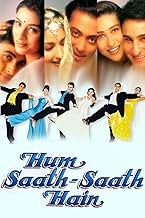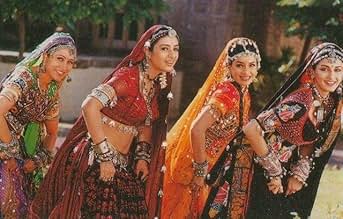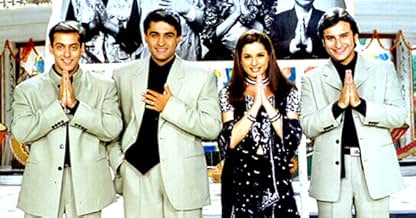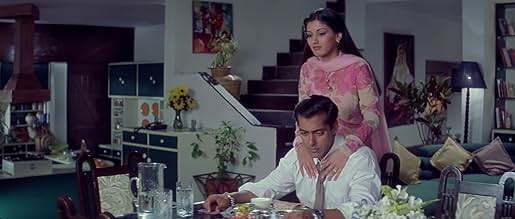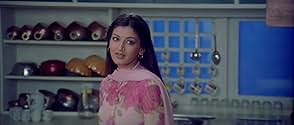AVALIAÇÃO DA IMDb
6,3/10
11 mil
SUA AVALIAÇÃO
Ramkishen e Mamta têm três filhos homens: Vivek, Prem e Vinod. Mamta é mais fria com Vivek, seu enteado, pensando no bem de seus dois filhos de sangue. Vivek aceita a decisão da madrasta com... Ler tudoRamkishen e Mamta têm três filhos homens: Vivek, Prem e Vinod. Mamta é mais fria com Vivek, seu enteado, pensando no bem de seus dois filhos de sangue. Vivek aceita a decisão da madrasta com obediência.Ramkishen e Mamta têm três filhos homens: Vivek, Prem e Vinod. Mamta é mais fria com Vivek, seu enteado, pensando no bem de seus dois filhos de sangue. Vivek aceita a decisão da madrasta com obediência.
- Prêmios
- 1 vitória e 6 indicações no total
Neelam Kothari
- Sangeeta Chaturvedi Pandey
- (as Neelam)
Alok Nath
- Ramkishan Chaturvedi
- (as Aloknath)
Reema Lagoo
- Mamta Awasthi Chaturvedi
- (as Rima)
Ajit Vachani
- Vakil
- (as Ajit Vachhani)
Rajeev Verma
- Mr. Adarsh
- (as Rajiv Verma)
Avaliações em destaque
Sooraj Barjatya's Hum Saath Saath Hain is his follow-up to the immensely successful Hum Aapke Hain Kaun. Barjatya has pretty much all the same ingredients here as well. The ensemble cast are all perfectly selected for their roles and have done a good job. Most outstanding of all in the film would be Mohnish Behl. Barjatya has once again written a very meticulous script with great timing by all the artists in bringing out Barjatya's vision from the paper to the screen. The one area where HSSH lacks in is the music. Though not a bad score by any means, it needed a bit more melody and pleasantness to enhance the moods of the film better. Also, the energy that HAHK had somehow seems to be missing. But to be fair to the film, Barjatya has once again presented a very sincere and heartfelt effort. Job well done. 8/10.
I saw my first Bollywood movie during a vacation to India in 2000. Since then, I have seen at least 15 and have collected seven of the more popular recent releases. This was the second movie I saw in the theaters there (the first was horrible except for an excellent dance number), and I enjoyed HSSH immensely. Even without subtitles (and I don't speak Hindu), the plot, easy to follow, was not a barrier to what I considered to be excellent singing, dancing, and entertainment. I loved Karishma Kaapoor and Saif Ali Khan, was exposed to several actors which appeared in subsequent movies which I enjoyed, and in short had a good time. I have purchased this movie to show to friends as their first up-close encounter with Bollywood. Since seeing this film, I have enjoyed only one movie, Kuch Kuch Hota Hai, more. I would recommend this movie to anyone but particularly to someone trying to learn fresh about this key segment of the movie industry.
Rajshri continued to produced wonderful and memorable flicks like Tapasya (1976 Dir. Anil Ganguly), Chit Chor (1976 Dir. Basu Chatterjee), Ankhiyon Ke Jharokhon Se (1978 Dir. Hiren Nag), Sunayana (1979 Dir. Hiren Nag), Humkadam(1980 Dir. Anil Ganguly), Naiyya (1980 Dir. Prashant Nanda), Saaransh(1984 Dir. Mahesh Bhatt) & Abodh (1984 Dir. Hiren Nag).
Most of these films presently now have more weaknesses then strengths. But at the time of their release, and when I viewed them during the 1980's, these films were very different in style and tone from the rest of conventional Hindi cinema. It is these films that help inspire forthcoming filmmakers, and innovate the bland Hindi cinema which is predictable and not satisfying.
While most of their production remains quite unknown to many audiences, since their films was mostly consistent of new cast and production crew (making them really experimental at times), their last three production has become the most popular films ever in the history of Indian cinema. The films Maine Pyar Kiya (1989), Hum Aapke Hain Koun (1994) & Hum Saath - Saath Hain (1999) had broken box-office records around the world. All three movies was directed by Rajshri in-house director Sooraj B. Barjatya.
The films each have a social message which looks at each stage of life....youth/love, love/marriage & family values. While I loved his first two movies, his present one was very disappointing as it falls behind by being too overly melodramatic, which at times become rather ambiguous to the whole setting and nature of the film.
The first half hour feels like a theater production when all the characters enter the stage with their own mannerisms and characteristics. While this part has been handled well, I fail to understand why the need for so many characters. I was totally lost when all the secondary characters just entered the house (without a doorbell?) and made themselves feel too much at home. This creates an unease in the overall flow of the film. Maybe its just me, but I do feel that too much escapism was wrong at the start as it becomes too demanding on our part to make believe.
Rather then break Hindi film conventions, which all Rajshri films have done in nearly all of their releases, Hum Saath - Saath Hain continues the trend set by Hum Aapke Hain Koun of an upper class family having functions, outings, businesses, and a big house. This in my view has been looked upon once too often, and seems rather tiring and predictable. This contrasted with what the director did for his first directorial debut Maine Pyar Kiya which, in 1989, resorted Hindi cinema back to the romantic genre for the 1990's. This helped the romantic genre become a profitable and popular format after one decade of violence and patriotism films.
Planning of shots, art direction and performances are well executed. This shows how the director is very structured in what he wants to be visually shown on screen. But while the visuals are pleasing the overall plot, which is reminiscent of a modern day Ramayan, seems to be rather outdated. It is nice to see togetherness in a family but his concept was way over premising. It kept most of Ramayan philosophy into the plot rather then to fuse/innovate it with modern day influx of westernization which has taken over India with the advent of satellite television and of commercialism of products. Thus the film is not as up to date with today's audience.
Another weakness detected in the film is the poor song score, which is also not in touch with audiences expectations. While the lyrics are very touching and heart warming (especially in the song 'Yeh To Such Hain' which is a dedication to parents), the music doesn't merit the soundtrack to be listened to on its own. Its decent enough while viewing the film, as both are suited as it twins well. However it lacks the soulful melodies heard in present films like Taal (1999). I presume due to the death of one of the music director it has impacted on the working technique once presented in the duo Raam - Lakshman. The background score is however very appropriate as it helps to interact with what the characters feel on screen.
Where there is a negative lies a positive and this film has many. Like I mentioned before all the pr-production work done really shows the creativity the director has for his characters. There are many characters in this film, and for the director to ensure what will each be made of mentally and physically shows very well on screen. He personifies them through their personality, para-language, body language and even hobbies. The excellent art direction by Bijon Das Gupta captured by the wide cinema scope frame of Rajan Kinagi shows all of this creation quite well, and adds marvel viewing.
Also the performance from all the cast, despite the weak plot, is very well handed due to the detail structure of the surround planning by the director. Karisma Kapoor, Aloknath, Tabu, Neelam and Saif Ali Khan displays wonderful moments of character acting, that surpasses most blockbuster stars currently in Indian cinema. Also Salman Khan performance is quite impressive despite having less screen time then most of the major characters. Here his shy charter is played to a tee and certainly contrast with his loud and crass characters in his past films like Pyaar Kiya To Darna Kiya (1998) and Hello Brother (1999).
Despite being harshly criticize by many film critics, and by some audiences, the film became the highest grossing Indian film of the year 1999. The film might be a favorite with family audiences, but for individuals who crave for something new won't find this film satisfying.
Most of these films presently now have more weaknesses then strengths. But at the time of their release, and when I viewed them during the 1980's, these films were very different in style and tone from the rest of conventional Hindi cinema. It is these films that help inspire forthcoming filmmakers, and innovate the bland Hindi cinema which is predictable and not satisfying.
While most of their production remains quite unknown to many audiences, since their films was mostly consistent of new cast and production crew (making them really experimental at times), their last three production has become the most popular films ever in the history of Indian cinema. The films Maine Pyar Kiya (1989), Hum Aapke Hain Koun (1994) & Hum Saath - Saath Hain (1999) had broken box-office records around the world. All three movies was directed by Rajshri in-house director Sooraj B. Barjatya.
The films each have a social message which looks at each stage of life....youth/love, love/marriage & family values. While I loved his first two movies, his present one was very disappointing as it falls behind by being too overly melodramatic, which at times become rather ambiguous to the whole setting and nature of the film.
The first half hour feels like a theater production when all the characters enter the stage with their own mannerisms and characteristics. While this part has been handled well, I fail to understand why the need for so many characters. I was totally lost when all the secondary characters just entered the house (without a doorbell?) and made themselves feel too much at home. This creates an unease in the overall flow of the film. Maybe its just me, but I do feel that too much escapism was wrong at the start as it becomes too demanding on our part to make believe.
Rather then break Hindi film conventions, which all Rajshri films have done in nearly all of their releases, Hum Saath - Saath Hain continues the trend set by Hum Aapke Hain Koun of an upper class family having functions, outings, businesses, and a big house. This in my view has been looked upon once too often, and seems rather tiring and predictable. This contrasted with what the director did for his first directorial debut Maine Pyar Kiya which, in 1989, resorted Hindi cinema back to the romantic genre for the 1990's. This helped the romantic genre become a profitable and popular format after one decade of violence and patriotism films.
Planning of shots, art direction and performances are well executed. This shows how the director is very structured in what he wants to be visually shown on screen. But while the visuals are pleasing the overall plot, which is reminiscent of a modern day Ramayan, seems to be rather outdated. It is nice to see togetherness in a family but his concept was way over premising. It kept most of Ramayan philosophy into the plot rather then to fuse/innovate it with modern day influx of westernization which has taken over India with the advent of satellite television and of commercialism of products. Thus the film is not as up to date with today's audience.
Another weakness detected in the film is the poor song score, which is also not in touch with audiences expectations. While the lyrics are very touching and heart warming (especially in the song 'Yeh To Such Hain' which is a dedication to parents), the music doesn't merit the soundtrack to be listened to on its own. Its decent enough while viewing the film, as both are suited as it twins well. However it lacks the soulful melodies heard in present films like Taal (1999). I presume due to the death of one of the music director it has impacted on the working technique once presented in the duo Raam - Lakshman. The background score is however very appropriate as it helps to interact with what the characters feel on screen.
Where there is a negative lies a positive and this film has many. Like I mentioned before all the pr-production work done really shows the creativity the director has for his characters. There are many characters in this film, and for the director to ensure what will each be made of mentally and physically shows very well on screen. He personifies them through their personality, para-language, body language and even hobbies. The excellent art direction by Bijon Das Gupta captured by the wide cinema scope frame of Rajan Kinagi shows all of this creation quite well, and adds marvel viewing.
Also the performance from all the cast, despite the weak plot, is very well handed due to the detail structure of the surround planning by the director. Karisma Kapoor, Aloknath, Tabu, Neelam and Saif Ali Khan displays wonderful moments of character acting, that surpasses most blockbuster stars currently in Indian cinema. Also Salman Khan performance is quite impressive despite having less screen time then most of the major characters. Here his shy charter is played to a tee and certainly contrast with his loud and crass characters in his past films like Pyaar Kiya To Darna Kiya (1998) and Hello Brother (1999).
Despite being harshly criticize by many film critics, and by some audiences, the film became the highest grossing Indian film of the year 1999. The film might be a favorite with family audiences, but for individuals who crave for something new won't find this film satisfying.
HSSH is a real family entertainer. Suraj Barjatya has made the movie such that every portion of the movie fits into the main story line without any hiccups. The movie is visually rich, the music is fine. Also this is a clean movie without any sex,violence & if you are a fan of good family entertainers this is a must see.
Excellent performance from all the actors and other technicians.
Excellent performance from all the actors and other technicians.
'Hum Saath Saath Hai' is a simple family drama. It's one of the films I enjoy most when watching with family. It's a colourful feel good film and not one that will make you seriously pick your brains. The moral of the story is that family should stick together, that's when they're the strongest. Just sit down and enjoy it without expecting a serious drama. The family tradition is nicely portrayed. Yes, it's larger than life and some might call it 'too good to be true' but it's entertaining. The set designs are impressive and the locales are spectacular (particularly the Rampur scenes). The songs are very pleasant and nicely add to the screenplay. In addition to that the dances have been beautifully choreographed. All the actors suit their roles very well. Tabu and Sonali add grace and sincerity to their characters. Tabu's downplayed expression in the scene right after Alok Nath and Reema Lagoo's argument is stunning. Sonali as the shy Preeti is amazing. She adds a lot of class and her body language is a standout. The two actresses are more than a positive addition. Karishma and Saif add to the humour. Saif is wonderful as the hyperactive Vinod as are Salman as the quiet Prem and Mohnish as the responsible Vivek. Alok Nath, Reema Lagoo, Shakti Kapoor and the rest of the cast are mostly brilliant. Neelam stands out as the sister. The three friends who play Lagoo's friends seem like caricatures. The plot is predictable but there's more to the film. I'd say it's one film best watched with the family. The only other Barjatya films I watched are 'Vivah' and 'Hum Aapke Hain Kaun' (so it's quite clear that his films aren't to be taken too seriously) but for me 'Hum Saath Saath Hai' definitely tops those two. I'd recommend watching and enjoying it with family.
Você sabia?
- CuriosidadesDuring the filming of this movie, Salman Khan, Saif Ali Khan, Neelam, Tabu and Sonali Bendre went hunting on a distant forest of Rajasthan and got involved in the infamous black buck poaching case.
- Erros de gravaçãoIn the song Sunoji Dulhan Satish Shah is shown tickling Salman from first row but later when Salman runs he is shown sitting in third row.
- Cenas durante ou pós-créditosIn the beginning, the six main characters (Saif Ali Khan, Karisma Kapoor, Salman Khan, Sonali Bendre, Tabu, and Mohnish Behl) are seen in suits and elaborate dresses lip-syncing to the title song while dancing as their three respective couples.
- Trilhas sonorasABCDEF - I Love You
Written by Shashank Banerji
Composed by Vijay Patil (as Raamlakshman)
Performed by Hariharan, Hema Sardesai, Shankar Mahadevan, Udit Narayan and Saif Ali Khan
Courtesy of Saregama HMV
Principais escolhas
Faça login para avaliar e ver a lista de recomendações personalizadas
- How long is Hum Saath-Saath Hain?Fornecido pela Alexa
Detalhes
- Data de lançamento
- País de origem
- Central de atendimento oficial
- Idioma
- Também conhecido como
- Hum Saath-Saath Hain
- Locações de filme
- Jodhpur, Rajasthan, Índia(location)
- Empresa de produção
- Consulte mais créditos da empresa na IMDbPro
Bilheteria
- Faturamento bruto nos EUA e Canadá
- US$ 2.005.094
- Fim de semana de estreia nos EUA e Canadá
- US$ 651.575
- 7 de nov. de 1999
- Faturamento bruto mundial
- US$ 2.005.094
- Tempo de duração2 horas 57 minutos
- Cor
- Mixagem de som
- Proporção
- 2.35 : 1
Contribua para esta página
Sugerir uma alteração ou adicionar conteúdo ausente

Principal brecha
What is the Mexican Spanish language plot outline for Nós Permanecemos Unidos (1999)?
Responda

